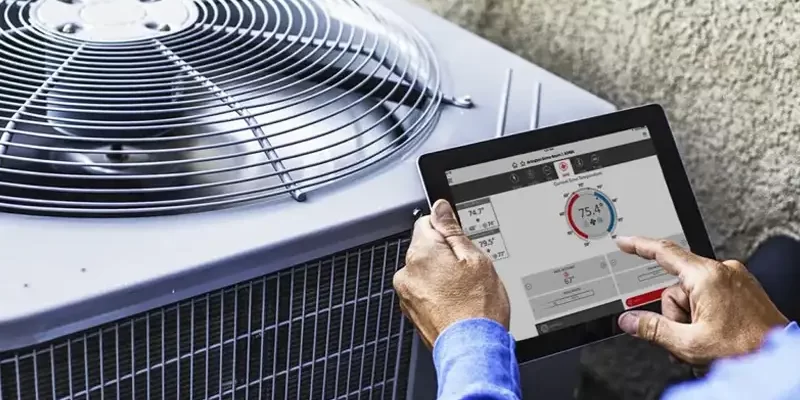In recent years, smart HVAC diagnostic dashboards have emerged as a game-changer in the climate control industry. These innovative tools are transforming how heating, ventilation, and air conditioning systems are monitored and maintained. Designed for a wide audience, including industry QA professionals, these dashboards offer enhanced insights and improved efficiency.
As the demand for efficient climate control increases, the role of smart HVAC diagnostic dashboards has become more crucial than ever. By providing real-time data and analytics, these dashboards help in identifying potential issues before they escalate into costly repairs, ensuring optimal system performance.

Understanding Smart HVAC Diagnostic Dashboards
Smart HVAC diagnostic dashboards are advanced platforms that integrate various technologies to monitor, analyze, and manage HVAC systems. These dashboards utilize sensors and IoT technology to collect data, which is then processed to provide actionable insights.
Key Features of Smart HVAC Diagnostic Dashboards
Some of the essential features of these dashboards include real-time monitoring, predictive maintenance, energy consumption tracking, and remote accessibility. These features not only enhance system reliability but also contribute to energy efficiency and cost savings.
Benefits of Using Smart HVAC Diagnostic Dashboards
The use of smart HVAC diagnostic dashboards offers numerous benefits. They improve system efficiency, reduce downtime, and lower maintenance costs. Additionally, they provide valuable data that can be used to optimize system performance and improve indoor air quality.
The Role of IoT in HVAC Diagnostics
IoT technology plays a pivotal role in the functionality of smart HVAC diagnostic dashboards. By connecting various components of the HVAC system, IoT enables seamless data collection and analysis, leading to more accurate diagnostics and timely interventions.
Enhancing Efficiency Through IoT Integration
Integrating IoT with HVAC systems allows for real-time data collection and analysis, which can significantly enhance system efficiency. This integration helps in identifying inefficiencies and optimizing system operations.
Predictive Maintenance with IoT
One of the significant advantages of IoT integration is predictive maintenance. By analyzing data patterns, IoT-enabled dashboards can predict potential failures, allowing for proactive maintenance and reducing the risk of system breakdowns.
Impact on Energy Consumption
Smart HVAC diagnostic dashboards contribute to energy efficiency by monitoring and optimizing energy consumption. By providing insights into usage patterns, these dashboards help in reducing energy waste and lowering operational costs.
Optimizing Energy Usage
Through continuous monitoring and analysis, smart HVAC diagnostic dashboards can identify areas of energy waste and suggest optimization strategies. This leads to significant energy savings and a reduced carbon footprint.
Cost Savings Through Energy Efficiency
By optimizing energy usage, businesses can achieve substantial cost savings. Smart HVAC diagnostic dashboards enable precise control over energy consumption, ensuring that systems operate efficiently without unnecessary expenditure.
Future Trends in HVAC Diagnostics
The future of HVAC diagnostics lies in further advancements in technology and increased adoption of smart solutions. As technology evolves, smart HVAC diagnostic dashboards will continue to offer more sophisticated features and capabilities.
AI and Machine Learning in HVAC
The integration of AI and machine learning in HVAC diagnostics is set to revolutionize the industry. These technologies will enable more accurate predictions, enhanced analysis, and automated decision-making processes.
Increased Connectivity and Integration
As more devices become connected, the integration of HVAC systems with other smart technologies will become more prevalent. This increased connectivity will lead to more comprehensive and efficient climate control solutions.
Implementing Smart HVAC Diagnostic Dashboards
Implementing smart HVAC diagnostic dashboards requires careful planning and consideration. It is essential to assess the specific needs of the system and choose a dashboard that offers the necessary features and capabilities.
Choosing the Right Dashboard
When selecting a smart HVAC diagnostic dashboard, it is crucial to consider factors such as compatibility, scalability, and ease of use. A dashboard that aligns with the system’s requirements and goals will ensure optimal performance.
Installation and Integration Process
The installation and integration process should be carried out by professionals to ensure seamless operation. Proper configuration and setup are vital to harnessing the full potential of the dashboard.
Challenges and Solutions
While smart HVAC diagnostic dashboards offer numerous benefits, there are challenges associated with their implementation. These challenges include data security concerns, integration complexities, and the need for ongoing maintenance.
Addressing Data Security Concerns
Ensuring data security is paramount when implementing smart HVAC diagnostic dashboards. It is essential to employ robust security measures to protect sensitive information and prevent unauthorized access.
Overcoming Integration Complexities
Integration complexities can be addressed by working with experienced professionals who understand the intricacies of HVAC systems and smart technology. Proper planning and execution are key to successful integration.
Case Studies and Success Stories
Numerous organizations have successfully implemented smart HVAC diagnostic dashboards, achieving significant improvements in system performance and efficiency. These case studies serve as valuable examples of the potential benefits.
Improved Efficiency in Commercial Buildings
In commercial buildings, smart HVAC diagnostic dashboards have led to improved efficiency and reduced energy consumption. By optimizing system operations, these dashboards have contributed to substantial cost savings.
Enhanced Performance in Residential Settings
In residential settings, smart HVAC diagnostic dashboards have improved comfort and indoor air quality. Homeowners have experienced enhanced system performance and reduced energy bills.
Conclusion
In conclusion, smart HVAC diagnostic dashboards are transforming the climate control industry by providing enhanced insights, improving efficiency, and reducing costs. As technology continues to advance, these dashboards will play an increasingly important role in optimizing HVAC systems and ensuring optimal performance.

FAQs
What are smart HVAC diagnostic dashboards?
Smart HVAC diagnostic dashboards are advanced tools that monitor, analyze, and manage HVAC systems using sensors and IoT technology.
How do these dashboards improve energy efficiency?
By providing real-time data and insights, smart HVAC diagnostic dashboards help in optimizing energy consumption, reducing waste, and lowering operational costs.
What are the challenges of implementing smart HVAC diagnostic dashboards?
Challenges include data security concerns, integration complexities, and the need for ongoing maintenance. Proper planning and professional installation can help address these challenges.
For more insights on HVAC technology, consider visiting HVAC Tools Using AI and this external source for further reading.
This article contains affiliate links. We may earn a commission at no extra cost to you.
